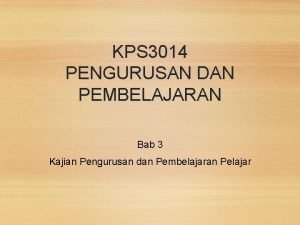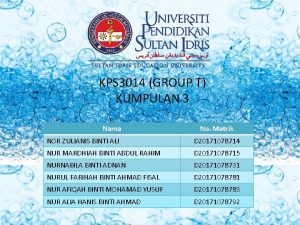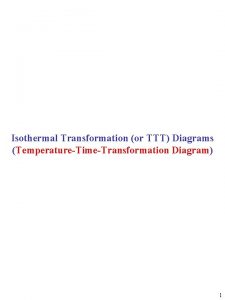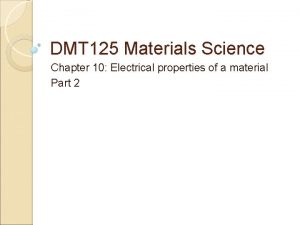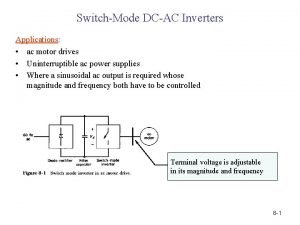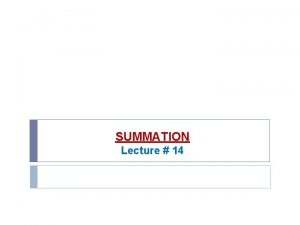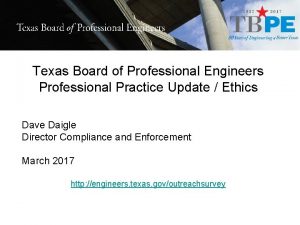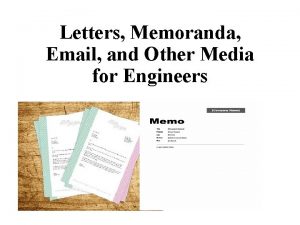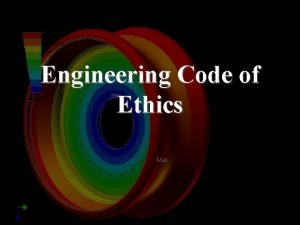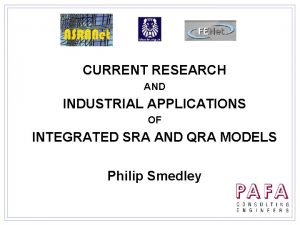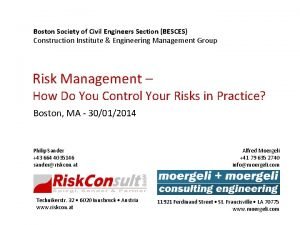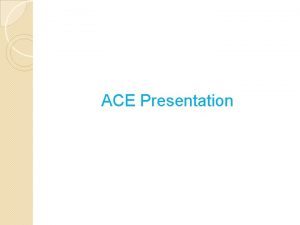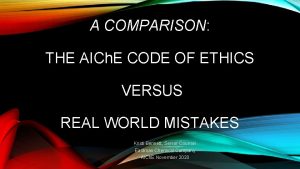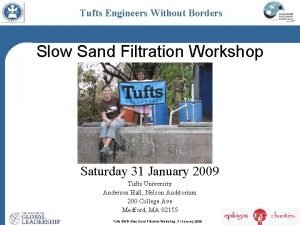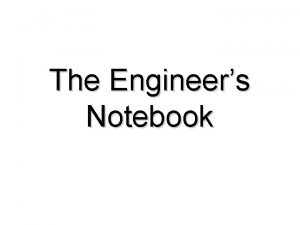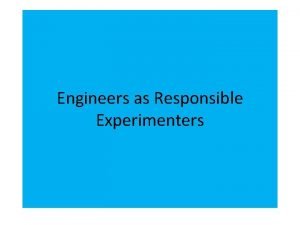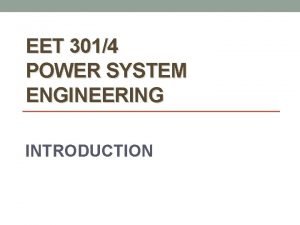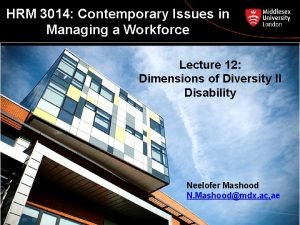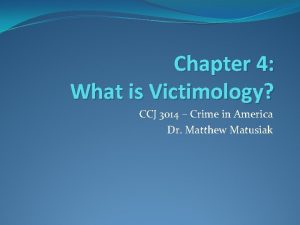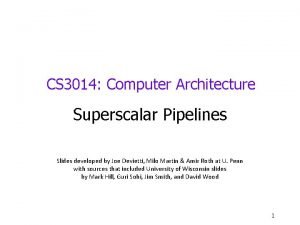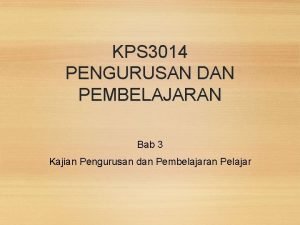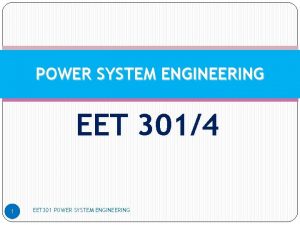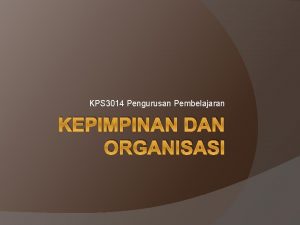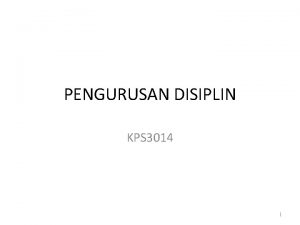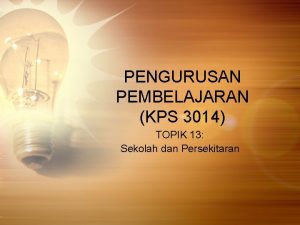Engineers in SocietyEE 3014 Lecture Series 1 Introduction












































- Slides: 44

Engineers in Society(EE 3014) Lecture Series 1

Introduction to Ro. HS and WEEE – Green Manufacturing and Alternative Materials for Ro. HS Professor Y. C. Chan Ph. D, FIEEE, FHKIE, FIEE, CEng Chair Professor of Electronic Engineering, City University of Hong Kong Director, EPA Centre Engineers in Society (EE 3014) Lecture Series 2

What is the meaning of n ? EU Directive 2002/95/EC of the European Parliament and of the council on the Restriction of the use of certain Hazardous Substances ( Ro. HS ) in electrical and electronic equipment Engineers in Society(EE 3014) Lecture Series 3

Why Important ? n $ Cost q q n Dutch Government blocked the shipment of 1. 3 M Sony Playstation system, 800 K accessories - combined value of over US $200 M in 2001. Cadmium in cables exceeds 0. 01% limit by 3 – 20 x. Health Fears q q Media reported that over 100 workers in two Chinese battery factories ( Huizhou, Southern China ) were suspected to be contaminated by cadmium in July 2004. Medical report states “ excessive levels of cadmium in blood”. Engineers in Society(EE 3014) Lecture Series 4

Summary on related directives Directive Ref. 2002/95/EC 2000/53/EC 94/62/EC 2004/12/EC (amendment ) Date 27 Jan 03 18 Sept 00 20 Dec 94 2 Nov 04 Objective Remarks Restriction of the use of certain hazardous substances in electrical and electronic equipment (EEE) and to contribute to the protection of human health and the environmentally sound recovery and disposal of waste EEE. 6 banned materials included Pb, Hg, Cr 6+, Cd and PBB / PBDE. Related consultation paper was issued to interested parties for review on 30/7/04. • Max. conc. value - 0. 1% by weight in homogeneous material for Pb, Hg, Cr 6+, PBB/ PBDE • Max. conc. value - 0. 01% weight in homogenous material for Cd. Measures at the prevention of waste from vehicles and at the re-use, recycling and other forms of recovery of end-of life vehicles (ELV) and their components. Related consultation papers issued on March 2003 and February 2004 , confirm the maximum concentration value limit to : • 0. 1% by weight per homogeneous material for Pb, Cr 6+ and Hg. • 0. 01% for Cd, which are not intentionally Amending directive 94/62/EC, on Packaging and Packaging Waste is to prevent packaging waste by encouraging packaging re-use and recycling while at the same time avoid distortions in the internal market. Engineers in Society(EE 3014) Lecture Series The targets defined are the following: • Recovery of minimum 60% by weight of the packaging waste • Recycling of at least 55% and a maximum 80% by weight of the totally of packaging materials, with a material-specific minimum recycling rate for plastic of 22. 5% • Max. sum of concentration levels of Pb, Cd, Hg and Cr 6+ -> 100 ppm by weight 5

Summary on related directives Directive Ref. 91/338/EEC 91/157/EEC 98/101/EC (amendment) 76/769/EEC Date Objective Remarks 18 Jun 91 Restriction on the use of Cadmium pigment (amending for the 10 th time Directive 76/769/EEC) The cadmium content (expressed as Cd metal) exceeds 0, 01 % by mass is prohibited in the finished products or components of products manufactured from polymers or copolymers of vinyl chloride and stabilized by substances. 3 Mar 91 22 Dec 98 27 Jul 76 The recovery and controlled disposal of those spent batteries and accumulators containing dangerous substances. Batteries and accumulators are prohibited with content: • More than 25 mg of mercury per cell, except alkaline manganese batteries, • More than 0. 025% of cadmium by weight, • More than 0. 4% of lead by weight, • Alkaline manganese batteries containing more than 0. 025% of mercury by weight Approximation of the laws, regulations and administrative provisions of the Member states relating to restrictions on the marketing and use of certain dangerous substance and preparations Engineers in Society(EE 3014) Lecture Series 6

Ro. HS Globalization EU Ro. HS Effective on 1 July 2006 - China Ro. HS US Ro. HS Maine, Texas, California may be effective on 1 July 2006 or extend to 1 Jan 2007 Engineers in Society(EE 3014) Lecture Series Will be implemented on 1 January 2007 Japanese electronics manufacturers have created market differentiation based on “green” products 7

Offences and Penalties UK Failing to comply the Ro. HS could result: Summary Conviction : Max. £ 5, 000 Indictment Conviction : Unlimited Fine director, manager or similar officer of the corporate body, they could be regarded as having committed the offence as well as the corporate body Defence: ‘due diligence’ is available where a person can show he took all reasonable steps and exercised all due diligence to avoid committing an offence. (include reference to an act or default or information given by a third party or that information in possession of the person making the claim) Engineers in Society(EE 3014) Lecture Series 8

Loss in Failing Compliance Other invisible penalty n n n Lost market competitiveness and business chance Product cannot sell in Europe, US and China markets. Reputation Damage Engineers in Society(EE 3014) Lecture Series 9

Ro. HS Documents n n n On request to provide technical documentation or other information to enforcement authority Record should be kept at least 4 years Self-declaration Engineers in Society(EE 3014) Lecture Series 10

China Ro. HS n The final draft of China Ro. HS, officially known as “The Administration on the Control of Pollution Caused by Electronic Information Products”will be released in early 2006. n The submission of China’s proposed Ro. HS-equivalent law in late September 2005 to the World Trade Organization. Restricted Product Categories: q q q Electronic Radar - Electronic Communication Broadcast and TV - Computer Household Electronic - Electronic Measurement & Instrument Electronic Products for special use Electronic Component - Electronic Application Electronic Material Engineers in Society(EE 3014) Lecture Series 11

China Ro. HS Regulation n China Ro. HS will apply to electronics manufactured in China for sale domestically as well as goods imported into China. n It does not apply to electronics made in China for export and it does not apply to military electronics. n Electronic products shall indicate the names and contents of toxic and harmful substances contained therein and the recyclability of such products. n From January 2007, products shall not contain lead, mercury, cadmium, hexavalent chromium, polybrominated biphenyls (PBB), polybrominated diphenyl ethers (PBDE) and other toxic and harmful substances. n Packaging-material use-and-declaration requirement stating that “nontoxic, harmless, readily degradable and recyclable materials shall be used as the packaging materials, and the materials ingredients of the packaging shall be clearly marked”. Engineers in Society(EE 3014) Lecture Series 12

EU & China Ro. HS Comparison EU Ro. HS China Ro. HS Legislation Promulgated legislation Expected to be promulgated by early 2006 Takes effect July 1, 2006 January 1, 2007 What happens at deadline Products must be in line with the directive or manufacturers face legal penalties Probably manufacturers will only be responsible for following labeling rules. Other manufacturer obligations look like they will be delayed. What’s restricted Six substances: lead, mercury, cadmium, hexavalent chromium, polybrominated biphenyls (PBB), polybrominated diphenyl ethers (PBDE). Also has a provision that includes “other toxic and harmful substances” but give no specifics. Who is responsible Producer = Brand Owner Unspecified. The OEM, distributor, product design house and/or others in the supply chain could bear some responsibility. Engineers in Society(EE 3014) Lecture Series 13

EU & China Ro. HS Comparison EU Ro. HS China Ro. HS Compliance process Companies exercise self-regulation. Putting products on the EU market means they are claiming compliance. Authorities may challenge the producer, who then backs up the compliance claim with sufficient documentation showing due diligence. Products and components imported into China will first stop at the port of entry and be tested for compliance before entering. Products and components for re-exporting are not addressed. Ro. HS Exemptions Yes, the list of exemptions for specific applications of restricted substances is growing. Exemption requests from companies and organizations are continually evaluated. None, but that’s expected to change. Labeling requirement None Extensive, including country of origin, names and contents of toxic and harmful substances contained in a product, a list of packaging material ingredients, printing a “environmentally safe period” time frame – a type of shelf-life date that establishes how long a product can be used before it leaks harmful substances. Review Every four years Annually Engineers in Society(EE 3014) Lecture Series 14

Which materials are banned ? ( Directive 2002/95/EC ) § § § Lead (Pb) - Used in virtually all solders, electronic components and many PWB’s. Cadmium (Cd) - Used in batteries (Ni. Cd), plastic stabilizers, platings. Mercury (Hg) -Used in some electrical components, batteries, pigments. Hexavalent chromium (Cr 6+) - Used in dyes, pigments, plating solutions, alloys. Polybrominated biphenyls (PBB) & Polybrominated diphenyl ethers (PBDE) - Both PBB and PBDE are used as flame retardants in plastics, PWB insulation. Effective from 1 July 2006 Engineers in Society(EE 3014) Lecture Series 15

Exceptions to Ro. HS (All exceptions will be reviewed every 4 years or less) 1. Lead: - in the glass of cathode ray tubes - in certain steel (<0. 35%), aluminum (<0. 4%) and copper alloys (< 4%) - in high melting temperature type solders - in solders for servers and Storage Arrays (Until 2010) - Lead in solders for network infrastructure equipment in electronic ceramic parts (i. e. piezoelectric components) 2. Mercury: in some lighting applications 3. Cadmium: Cd plating 4. Hexavalent chromium in absorption refrigerators 5. Further exceptions are still under discussion. Engineers in Society(EE 3014) Lecture Series 16

Where can we find the banned substance? Pb Pb-Sn Alloy • • most common used in solders; Terminations, PCB coatings, component lead finishes, & cable (PVC). Engineers in Society(EE 3014) Lecture Series 17

Commonly Used Pb-Free Solder Melting points of the common Pb-free solder have been determined precisely, such as: System 300 250 Eutectic Temp (ºC ) Sn 3~3. 5 Ag 0. 5~0. 7 Cu 221 217 - 218 T (℃) 200 Sn 3. 5 Ag 150 100 Sn 0. 5~2. 8 Ag 0. 5~0. 7 Cu 1~3. 0 Bi 214 - 220 Sn 2. 8 Ag 15 Bi 136 - 197 Sn 8 Zn 3 Bi 193 - 199 Peak temp: 240~255 o. C 220 o. C or Higher 180 o. C Pre-heating 150 o. C Reflow time: 30± 30 s 90± 60 s 50 0 Reflow Soldering Time, sec A schematic view of a reflow profile of a typical lead-free soldering process Engineers in Society(EE 3014) Lecture Series 18

Component lead coating: Pb-free coating • • • Electroplated tin, Electroless Nickel/Immersion Gold, Immersion Silver, Electrolytic Gold, Palladium/nickel - used on some semiconductor leadframes, good wetting properties but higher price Surface finish on the solder bond pad of PCB/BGA substrate: • • Organic Solderability Preservatives (OSP) - lower cost - thin coating, thus easily damaged Nickel/gold - good alternative - expensive Engineers in Society(EE 3014) Lecture Series 19

Issues in using Pb-free solders ØReplacement of lead in solders costly material to replace, difficult to process, less reliability data • Lower solderability - Higher surface tenson cannot spread easily • Higher reflow profile - Increase board warpage. • Tin Whisker - An elongated single crystal of pure tin - Potential failure risk by short circuits Engineers in Society(EE 3014) Lecture Series 20

Where can we find the banned substance? Cd Cadmium ( Cd ) • a natural-occurring element in the earth’s crust - often found in combination with other elements, e, g, oxygen ( cadmium oxide, Cd. O ), chlorine ( cadmium chloride, Cd. Cl 2 ), or sulfur ( cadmium sulfide, Cd. S ) • not corrode easily, when used as a sacrificial coating (dual qualities of lubricating at minimal thickness and superior sacrificial corrosion protector). • used in products such as rechargeable batteries ( Ni. Cd ), plastic stabilizers, electroplating coatings, metal coating, pigments, electrical contact alloys for relays and switch, etc. Engineers in Society(EE 3014) Lecture Series 21

Cadmium ( Cd ) - Human health issues • Cd. O is a cancer-causing agent– especially prostate and kidney cancer in humans (carcinogen). • Cd. O fumes: - - toxic to the respiratory system (destroy epithelium layer) high exposure results in severe bronchial and pulmonary irritation. also hamper the development and function of immune system, reproductive organs and nervous system Engineers in Society(EE 3014) Lecture Series 22

Any alternative material to replace Cd in electroplating ? Aluminum Ion Vapour Deposition System ( AIVD ) • • used in place of cadmium in the electroplating industry. advantages include: - - no hazardous materials (HM) required and generated prevents employee exposure to HM eliminates the need for environmental permits prevents corrosion better than Cd coatings in acidic environments the coatings stand up to higher temperatures than Cd allows for thicker coatings and a more uniform coating Engineers in Society(EE 3014) Lecture Series 23

Any alternative material to replace Cd ? Zinc-based replacement in electroplating industry such as: • Zinc-Nickel alkaline plating bath: - good corrosion resistance properties uniform thickness during coating process - better wear resistance but lack of lubrication - • Zinc-Cobalt acidic plating bath: - its plating bath has higher cathode efficiency higher plating speed but variable current density Engineers in Society(EE 3014) Lecture Series 24

Any alternative material to replace Cd ? Sn-based replacement in electroplating industry such as: • Tin-Nickel acid / near neutral bath: - good resistance to corrosion - also has good ductility - very decorating in appearance • Tin-Zinc acidic bath : - better appearance - excellent ductility Engineers in Society(EE 3014) Lecture Series 25

Any alternative material to replace Cd ? – cont. Cadmium in relays : • Cd is used in contact buttons as Ag-Cd. O: Although Ag is an excellent conductor, it is a soft metal. Cd. O is alloyed with Ag to improve its welding and errosion properties without destroying the electrical and thermal properties. • Ag-Sn. O is a targeted replacement: The performance not yet as good as Ag-Cd. O. Also cost is higher. Different additions are under investigation to improve its performance. Engineers in Society(EE 3014) Lecture Series 26

Any alternative material to replace Cd ? – cont. Cadmium in Battery : Used as an active electrode material in a rechargeable, alkaline battery. • Lithium ion battery - Major application : already started to use in cellular phones, notebook, PCs, PDAs - Advantage : high energy density , high capacity, light weight - Disadvantage : expensive • Nickel Metal Hydride battery - Major application : already started to use in portable audio products, digital cameras, PDA - Advantage : rapid charging rate - Disadvantage : expensive Engineers in Society(EE 3014) Lecture Series 27

Where can we find the banned substance? Hg • Mercury : metal in liquid form in room temperature. Do not oxidize at room temperature. • Very small amount of Hg can do a significant damage to the environment. For example, 1 gm of Hg per year is enough to contaminate all the fish in lake with a surface area of 8 hectares. • Metallic mercury – use in producing chlorine gas and caustic soda and commonly apply to use in thermometer, dental fillings, batteries. • In electronics industry thermal indicators, relays, sensors, fluorescent lamp , switches, sensors, etc. Engineers in Society(EE 3014) Lecture Series 28

Quantitative Exemptions of Hg As per the Directive exemptions : • Mercury in compact fluorescent lamps ≤ 5 mg per lamp. • Mercury in straight fluorescent lamps purpose not exceeding : - halophosphate 10 mg - triphosphate with normal lifetime 5 mg - triphosphate with long lifetime 8 mg • Mercury in straight fluorescent lamps for special purposes The amount of mercury used in the fluorescent lamps may affect the lifetime of the product i. e. % of weight of Hg decrease the lifetime of the product may also decrease. Engineers in Society(EE 3014) Lecture Series 29

Any alternative of Hg ? • No viable replacements for Hg-fluorescent lamp yet. • Sodium vapor lamps: - Ne and Ag gas + Na Vapor. Na vapor emits yellow light – make all the objects more or less yellow. • Sulfur lamps: - Matching the sun light but again harmful because of S. • For some mercury wetted relays, may prefer to use gold plated or silver plated ( Ag. Ni / Ag. Sn. O ) contacts as alternative. Engineers in Society(EE 3014) Lecture Series 30

6+ Cr Where can we find the banned substances? Hexavalent Chromium ( Cr 6+ ) is generally produced by industrial processes, and used in industries such as : - Cr 6+ • Pigments, catalysis, plating and tanning • Parts with a metal frame ( e. g. Motor, Transformers, etc. ) • Screws, nuts, some parts / areas that are chromate treated ( e. g. AC adaptor, variable resistor, driver unit, etc. ) Engineers in Society(EE 3014) Lecture Series 31

Why use hexavalent chromium ( Cr 6+ ) Used as a surface finish because of: • low coefficient of friction • High hardness, excellent corrosion resistance, high heat resistance • Anti-galling properties (sliding on the surface without pressure ) Engineers in Society(EE 3014) Lecture Series 32

Chromium Exists as Several Chemical Species • Most common oxidation states: 0, +3, +6 0: Elemental Chromium (Cr) +3: Trivalent Chromium, Species: Cr 3+, Cr 2 O 3 +6: Hexavalent Chromium, Species: Cr 6+, Cr. O 42 -, Cr 2 O 7 - • Cr(VI) is much more toxic, stable and mobile than Cr(III) • Cr(VI) is a known human carcinogen, Cr(VI) is also a respiratory tract irritant. • Hexavalent chromium (Cr 6+ ) exists in alkaline, strongly oxidizing environments • Trivalent chromium (Cr 3+ ) exists in moderately oxidizing and reduced environments Engineers in Society(EE 3014) Lecture Series 33

Can Cr 6+ be replaced in plating process ? • using trivalent chromium plating baths ( but with inferior performance and poorer corrosion resistance ) • Nickel or Nickel and cobalt alloys • Other techniques used for plating such as: - Electroless plating - Nickel replacement for chromium - metal ions in a dilute aqueous solution are deposited onto a substrate by means of a continuous chemical reaction. - Chemical vapor Deposition ( CVD ), surface hardening, thermal spraying, physical vapor deposition, etc. - Organic Polymer Films - Such as polyacrylate, polyethylene waxes, etc. Engineers in Society(EE 3014) Lecture Series 34

The differences between Cr 3+ and Cr 6+ in terms of plating The major disadvantage of the current process of chrome plating is that it requires the use of chromic acid-based electrolytes comprising Cr 6+. Consideration Cr 3+ Cr 6+ Ease of burning Very hard Easy Ease of rinsing Easy Not easy Skin contact Mild effect, similar to nickel Strong acid burn and ulceration Waste treatment Easy Not easy Mistiness Similar to nickel Heavy and toxic Color of deposit Metallic white to pewter Blue-white, “chrome” color Engineers in Society(EE 3014) Lecture Series 35

Where can we find the banned substances ? Polybrominated Biphenyls (PBBs ) and Polybrominated Diphenyl Ethers ( PBDEs ) Commonly used in flame retardants ( FR ) in a variety of plastics to meet stringent global fire safety standards ( e. g. UL 94 – V 0 ) - TV / Display Cabinets - PCB – epoxy resin - Wire / cable insulation and connectors Mostly with Polystyrene, Terephthalates, Polyamides, Polycarbonates, Polypropylene. Engineers in Society(EE 3014) Lecture Series 36

Background information about PBB and PBDE • Brominated flame retardant ( BFR ) has been the largest market group because of - low cost - high performance efficiency • It will react and form polybrominated dibenzo-p-dioxins (PBDD) and polybrominated dibenzofurans (PBDF) after its reaction to put down fire. Both are carcinogenic elements Engineers in Society(EE 3014) Lecture Series 37

Background information about the PBB and PBDE Chemical structure of the monomer: Deca-bromo-biphenyl is a monomer of PBB Deca-bromo-diphenyl-ether is a monomer of PBDE Engineers in Society(EE 3014) Lecture Series 38

Alternatives – PBB & PBDE • Tetra-bromobisphenol A (TBBPA) - commonly used both as a reactive flame retardant or as an additive flame retardant in PWB. • Non-halogenated flame retardants - Al(OH)3 and other hydroxide: Currently the most widely used flame retardant. Al(OH)3 Al 2 O 3 + H 2 O ; decompose at 200 o. C Mg(OH)3 Mg 2 O 3 + H 2 O ; decompose at 300 o. C water vapor cool the substrate during heating and also dilute the gas phases Engineers in Society(EE 3014) Lecture Series 39

Non halogenated flame retardant – cont. • Zinc Borate (Zn. BO 3): - act by endothermic reactions and by the formation of a glassy coating protecting the substrate. • Antimony Oxide (Sb 2 O 3): - Works together with a halogen-containing compound • Common disadvantages: - Difficult to incorporate - Require high loading to be effective Engineers in Society(EE 3014) Lecture Series 40

Trade-offs of BFR Alternatives in PWB Chemical Strength Weakness Antimony Trioxide Low Toxicity to aquatic organisms May be toxic to humans if inhaled Aluminum Hydroxide Low toxicity Decomposes during soldering Magnesium Low toxicity Zinc Borate Low toxicity to humans Toxic to aquatic organisms Red Phosphorus Non-toxic Highly flammable May degrade Source : HDP User Group, International Inc. Engineers in Society(EE 3014) Lecture Series 41

Other Restricted Substance ? Restricted Substance Example Usage Asbestos Brake Lining pad, abrasive insulator, pigment, paint, adiabatic material Azo Colorants Pigment, dyes, colorant Ozone Depleting Substances Refrigerant, foaming agent, extinguish ant Polychlorinated Biphenyls ( PCBs ) Insulating oil, lubricant oil, electrical insulation medium Tributyl Tin ( TBT ) and Triphenyl Tin ( TPT ) Stabilizer, anti-oxidizer, antibacterial, etc. The above-listed restricted substances have not been used for a long time. Engineers in Society(EE 3014) Lecture Series 42

Summary • No exact or drop-in replacement ! • Several alternative materials have been recommended for each of the banned materials • There is not yet much field data available for the new materials!! • Most of the cases, the alternative materials are costly and inferior in performance • More R & D is needed in near future Engineers in Society(EE 3014) Lecture Series 43

Thank You This document is downloaded from www. surfinetek. com Engineers in Society(EE 3014) Lecture Series 44
 Pengurusan pelbagai budaya kps
Pengurusan pelbagai budaya kps Kps 3014
Kps 3014 Fsu cop 3014
Fsu cop 3014 Aoe 3014
Aoe 3014 Pembangunan dan perkembangan sahsiah diri murid
Pembangunan dan perkembangan sahsiah diri murid 01:640:244 lecture notes - lecture 15: plat, idah, farad
01:640:244 lecture notes - lecture 15: plat, idah, farad Introduction to materials science for engineers chapter 10
Introduction to materials science for engineers chapter 10 Introduction to materials science for engineers chapter 10
Introduction to materials science for engineers chapter 10 Introduction to matlab for engineers
Introduction to matlab for engineers Geology lecture series
Geology lecture series Dcac lecture series
Dcac lecture series Maclaurin series vs taylor series
Maclaurin series vs taylor series Heisenberg 1925 paper
Heisenberg 1925 paper Maclaurin series vs taylor series
Maclaurin series vs taylor series Taylor frederick
Taylor frederick Ibm p series server
Ibm p series server In current series feedback topology mixing is
In current series feedback topology mixing is Series aiding and series opposing
Series aiding and series opposing Sum of infinite series formula
Sum of infinite series formula Introduction to biochemistry lecture notes
Introduction to biochemistry lecture notes Introduction to psychology lecture
Introduction to psychology lecture Introduction to algorithms lecture notes
Introduction to algorithms lecture notes Arn 1
Arn 1 Monica suter
Monica suter Kinds of engineering
Kinds of engineering Vector mechanics for engineers statics 12th
Vector mechanics for engineers statics 12th Tbpe roster
Tbpe roster Limra consulting engineers
Limra consulting engineers Dear engineers email
Dear engineers email Georgia engineer continuing education
Georgia engineer continuing education When did engineering emerge
When did engineering emerge The engineers creed
The engineers creed Palomar engineers end fed antenna
Palomar engineers end fed antenna Znm consulting engineers
Znm consulting engineers Besces
Besces Bg consulting engineers
Bg consulting engineers Applied statistics and probability for engineers 6th
Applied statistics and probability for engineers 6th Associated consulting engineers
Associated consulting engineers American institute of chemical engineers code of ethics
American institute of chemical engineers code of ethics Line of action of force
Line of action of force Cattle feedlot designs
Cattle feedlot designs Tufts engineers without borders
Tufts engineers without borders Institute of engineers nashik
Institute of engineers nashik Engineering notebook standards
Engineering notebook standards Vector mechanics for engineers statics 10th edition
Vector mechanics for engineers statics 10th edition
